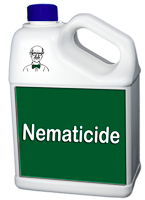 Nematodes are
generally microscopic roundworms although some may
be seen with the help of a hand lens of 10 power.
There are many different types of nematodes but the
ones important to the landscape gardener fall into
three categories.
Nematodes are
generally microscopic roundworms although some may
be seen with the help of a hand lens of 10 power.
There are many different types of nematodes but the
ones important to the landscape gardener fall into
three categories.
-
Beneficial
Nematodes - Although we gardeners usually
have negative things to say about nematodes, the
fact is that there are some that are beneficial
to our garden. Some of them are parasites of
such critters as cutworms, corn earworm and
slugs. They can help to keep these and certain
other pests in line.
-
Root Nematodes
- Some species of nematodes attack the roots of
plants and, perhaps, the most common of these is
the root knot nematode. It causes growths
(galls) on the root systems which cause the loss
of vigor of the plant.
-
Foliar
Nematodes - A few nematodes feed in the
leaves of plants. Perhaps the most important
current pest of this type is the foliar nematode
that attacks
hosta plants.
Nematicides are
pesticides made specifically to kill the nematode
pests of plants. Many of them are broad spectrum
poisons and often have to be quite volatile so that
they will move down into the soil where the
nematodes live. This trait can make them potentially
very dangerous to use so very few are available to
the home gardener. Generally, you need a license or
special training to purchase and use many of the
nematicides.
Work is being done on
finding less dangerous but effective "natural" based
miticides. Some of these are based on garlic, neem
cake, marigolds and others.



